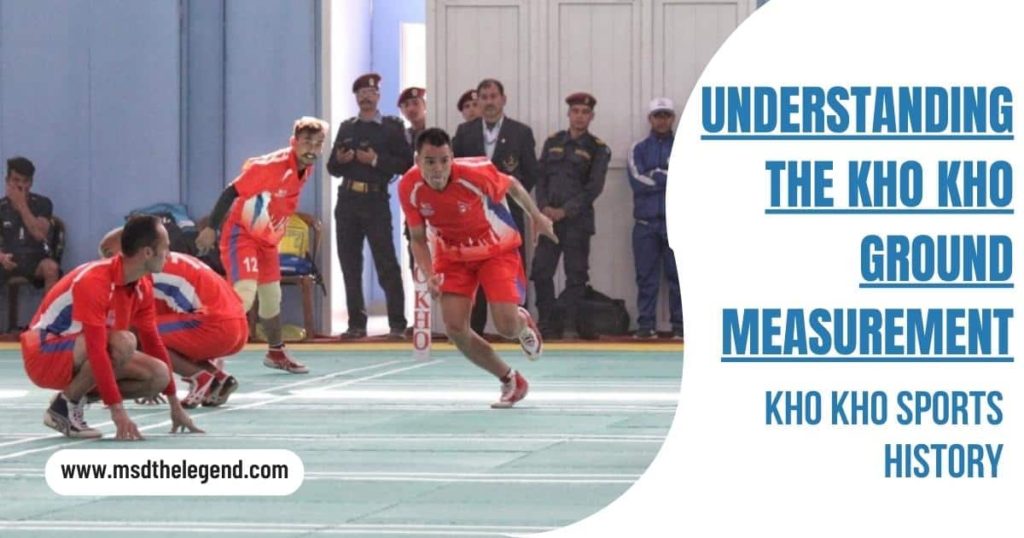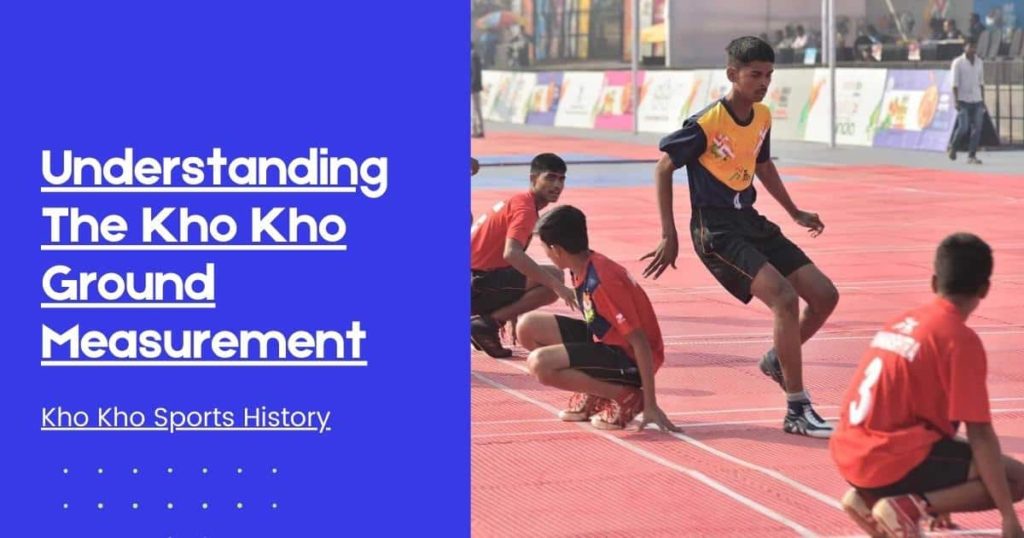Kho Kho is not just a sport, it’s a cultural emblem that has tranformed time and geographical perimeter. This Indian originated game holds a unique position in the field of sports, boasting a rich history, cultural significance, and a fascinating evolution that has earned it a special place in the hearts of both players and enthusiasts. Let’s dive into the captivating journey of Kho Kho and explore What is Kho kho? Kho Kho sports history, how to play Kho Kho? what is kho kho ground measurmets? its impact on culture, regional relevance, and its transformation into a recognized sport.
Table of Contents
A Brief History of Kho Kho
The origins of Kho Kho can be set back to ancient India, where it was known as “Chase.” This traditional game was often played in open spaces and village courtyards, providing a recreational outlet for individuals of all ages. The sport’s objective is simple yet exciting, the chasing team aims to tag players of the opposing team, who must evade being touched while demonstrating their agility and swiftness. There are some strict rule and regulations, And mainly focused on kho kho ground measurement
Cultural and Regional Relevance
Kho Kho isn’t just about athleticism; it carries deep cultural significance. It fosters companionship and teamwork among players, promoting values of cooperation and unity. This team oriented approach aligns seamlessly with the communal ideology of Indian society. Moreover, Kho Kho transcends age and gender barriers, making it an inclusive activity that brings communities together.
In various Indian festivals and events, Kho Kho remains a centerpiece. Its vibrant presence resonates deeply with the diverse cultures that dot the India, reflecting the nation’s commitment to preserving its heritage.
Evolution of Kho Kho as a Sport
From its humble beginnings as a recreational sport, Kho Kho has transformed into a competitive sport with structured rules and regulations. The introduction of formal leagues, championships, and national tournaments, and international championship has elevated Kho Kho’s status, attracting attention from athletes, sports enthusiasts, and even international audiences.
The game’s evolution hasn’t fewer its cultural essence. Instead, it has amplified its significance by providing a platform for players to showcase their talents, foster sportsmanship, and build character. The transition from village playgrounds to national arenas has given Kho Kho the recognition it deserves as a sport that evelop athleticism, strategy, and tradition.

A Comprehensive Look at IPL vs BBL: Comparing the Cricketing Powerhouses in 2024


What is an Over in Cricket: A Simple Guide to Understanding Cricket in 2024
The Essence of Kho Kho Ground Measurement
Understanding the Importance of Accurate Kho Kho Ground Measurement
In the energetic world of sports, attention is paramount. When it comes to a dynamic game like Kho Kho, where speed, agility, and strategy intertwine, accurate kho kho ground measurement emerges as a important factor that can make or break the game. The dimensions of the Kho Kho field go beyond mere numbers, they shape the very essence of the sport, impacting everything from fair play to gameplay strategy.
Role in Ensuring Fair Play and Competition
Imagine a Kho Kho match where the field dimensions are inconsistent or inaccurately marked. This scenario could lead to imbalances in the gameplay, favoring one team over the other. Accurate kho kho ground measurement serves as the guardian of fairness, ensuring that each team has an equal and level playing field, quite literally. It eliminates any undue advantage that might arise from uneven kho kho ground measurements, thereby upholding the spirit of fair competition.
Moreover, precise kho kho ground measurements prevent the manipulation of field dimensions to gain an upper hand. This safeguards the integrity of the sport and fosters an environment where victory is earned through skill, strategy, and teamwork.
Impact on Strategy and Gameplay
In Kho Kho, every inch of the field counts. Accurate kho kho ground measurement profoundly influences the tactics employed by teams. The knowledge of precise field dimensions allows players and coaches to strategize effectively, tailoring their approaches to exploit every available space strategically. It shapes the decisions regarding positioning, chasing, and evading, contributing to the dynamic ebb and flow of the game.
Furthermore, kho kho ground measurements influence the pace of the game. A larger field might encourage a more defensive approach, while a smaller one could prompt a more aggressive and rapid style of play. Thus, understanding the dimensions of the ground empowers players to adapt their gameplay based on the available space, fostering versatility and resourcefulness.
Standard Dimensions of a Kho Kho Ground
Kho Kho, a sport deeply rooted in Indian culture, is known for its agility, strategy, and speed. To maintain the integrity and fairness of the game, specific dimensions for the Kho Kho ground have been established. These standardized measurements ensure that every match is played on an even field, providing equal opportunities for both teams. Let’s delve into the key dimensions and boundary lines that shape the Kho Kho ground.
Length and Width Specifications
The Kho Kho ground’s dimensions are critical to the game’s dynamics. The standard length of a Kho Kho ground is approximately 29 meters (95 feet), while its width measures around 16 meters (52 feet). This rectangular layout creates a balanced playing area that challenges players’ agility and teamwork.
Boundary Line Demarcation
The Kho Kho ground is demarcated with clear boundary lines that define the playing area. The four sides of the ground are marked by boundary lines, setting the boundaries within which the action unfolds. These lines are crucial in determining whether a player is within the field or out of bounds during the game.
Centerline and Cross Line Details
The centerline, also known as the “Kho Kho line,” divides the ground into two equal halves. It is positioned parallel to the shorter sides of the ground, creating a balanced distribution of space for both teams. The two halves facilitate seamless gameplay and allow players to strategize effectively.
Cross lines, also known as “bonus lines,” are drawn perpendicular to the centerline. These lines are placed at a distance of 12 meters (39 feet) from the centerline on both sides. Cross lines play a pivotal role in the game, as they serve as the zones where the chasing team positions its defenders. Players in these zones aim to tag members of the opposing team as they attempt to evade capture.


How To GHD Sports IPL Live 2020 Latest (August Updated) Ind Vs West Indies?

Creating Top-notch Sports Facilities in Schools: Building a Sports Facility in 24-25
The Technicalities of the Playing Arena
The technicalities of the field layout are not mere details; they shape the essence of the game, influencing tactics, player positioning, and the overall flow of the match. Let’s delve into the intricacies of the playing arena, including the placement of starting and finishing lines, distinctions between base and bonus lines, and the significance of kho kho poles.
Starting and Finishing Line Placement
The placement of starting and finishing lines is fundamental to the flow of a Kho Kho match. The starting line, often referred to as the “Kho Kho line,” is positioned at the center of the shorter sides of the ground. This line marks the point from which the chaser initiates their pursuit of the runners.
Conversely, the finishing line is located at the opposite end of the ground. This line is where the runners aim to reach to complete their turn, evading the chaser’s tag. The strategic positioning of these lines ensures that the game maintains its dynamic nature, balancing the roles of chasers and runners.
Base and Bonus Line Distinctions
The Kho Kho ground features two distinct types of lines: base lines and bonus lines. Base lines are the lines parallel to the shorter sides of the ground, defining the boundary of the playing area. These lines determine whether a player is within the field or outside of bounds.
On the other hand, bonus lines, often referred to as “cross lines,” are perpendicular to the centerline. These lines are drawn at a distance of 12 meters (39 feet) from the centerline on both sides. Bonus lines serve as designated zones for the defending team’s players. These players strive to tag the runners from the opposing team as they attempt to cross these lines, adding an extra layer of strategy to the game.
Positioning of the Kho Kho Poles
Kho Kho poles are an integral part of the game, serving as landmarks and reference points. These poles are positioned at the corners of the ground, marking the boundary lines. They play a critical role in determining whether a player has successfully tagged a pole to initiate a turn or evaded a tag while running.
The kho kho poles not only serve a functional purpose but also contribute to the visual aesthetics of the playing arena. They stand as silent witnesses to the intensity, strategy, and agility that define the game.
Measurement Tools and Techniques in Kho Kho Ground Preparation
Kho Kho, a sport that hinges on precision and accuracy, extends its demand for meticulousness to the preparation of its playing arena. The process of measuring and marking the Kho Kho ground requires advanced tools and techniques that ensure fairness and uniformity. Let’s explore the evolution from traditional methods to modern technology, the surveying equipment employed for precise measurement, and the pivotal role of GPS and laser technology in the process.
Traditional Methods vs. Modern Technology
In the past, preparing a Kho Kho ground involved manual labor and traditional measurement methods. Rope, bamboo sticks, and simple measuring tools were used to approximate the dimensions of the field. However, these methods often led to inconsistencies and inaccuracies, potentially affecting the outcome of matches.
Modern technology has revolutionized the field preparation process. Advanced tools and techniques have replaced rudimentary methods, ensuring that the dimensions are exact and consistent. This shift has significantly elevated the integrity of the game and the fairness of competitions.
Surveying Equipment Used for Precise Measurement
Surveying equipment plays a pivotal role in accurately measuring and marking the Kho Kho ground. Theodolites, electronic distance measurement (EDM) devices, and total stations are among the tools used to achieve precision. Theodolites enable precise angle measurements, while EDM devices provide accurate distance measurements. Total stations combine both angle and distance measurement capabilities, offering a comprehensive solution for ground preparation.
Role of GPS and Laser Technology
Global Positioning System (GPS) technology has further enhanced the accuracy of Kho Kho ground measurement. GPS devices can provide geospatial coordinates with high precision, ensuring that the Kho Kho ground’s dimensions are in line with regulations. Laser technology, specifically laser distance meters, offers efficient and rapid measurements, reducing the time required for ground preparation.
The integration of GPS and laser technology has not only made the measurement process more accurate but has also expedited the entire preparation phase, allowing for timely and consistent marking of the playing arena.
Factors Influencing kho kho Ground Measurements
Ground measurements in Kho Kho play a pivotal role in ensuring fair play, competitiveness, and the overall quality of the game. However, these measurements are not just determined by arbitrary numbers; they are influenced by various factors that need careful consideration. Let’s explore the key factors that influence kho kho ground measurements, including geographical considerations, climate and surface impact, and the maintenance and preparation of the ground.
Geographical Considerations
The geographical location of a Kho Kho ground can significantly impact its dimensions. Grounds situated on uneven terrain might require special adjustments to maintain uniformity in dimensions. The natural contours of the land, such as slopes or dips, can affect the placement of boundary lines, the accuracy of bonus lines, and even the length of the ground itself. Surveyors must account for these geographical variations to ensure a level playing field for all teams.
Climate and Surface Impact
Climate plays a vital role in the preparation and maintenance of the Kho Kho ground. Areas prone to heavy rainfall might experience soil erosion, affecting the ground’s surface over time. Extreme weather conditions can lead to wear and tear, altering the field’s dimensions and overall structure. It’s imperative to implement proper drainage systems to prevent water accumulation that could impact the ground’s integrity. The choice of materials for marking lines, such as paint or chalk, should also withstand varying weather conditions to maintain accurate measurements.
Maintenance and Preparation of the Ground
Regular maintenance is crucial to preserving the accuracy of kho kho ground measurements. The ground’s surface must be level and well-maintained to ensure fair play. Any irregularities or inconsistencies in the surface could lead to unintended advantages or disadvantages for players. Proper care and preparation involve regular inspections, repairs, and adjustments to keep the ground in optimal condition. Adequate markings, from boundary lines to bonus lines, must be diligently maintained to uphold the integrity of the game.

Cricket Dynamos: Ultimate Expectation From The Newly Promoted Team in 2024



Adhering to International Standards
Maintaining uniformity in ground dimensions is paramount in Kho Kho, especially when it comes to adhering to international standards. The consistent application of kho kho ground measurements ensures fairness, competitiveness, and the spirit of the game across different countries and regions. Let’s delve into the significance of comparing ground dimensions across countries, the importance of complying with Kho Kho Federation regulations, and the implications of adhering to international standards for international tournaments.
Comparing Ground Dimensions Across Countries
Kho Kho’s popularity extends beyond national borders, and different countries have embraced the sport with their own unique fervor. However, to ensure a level playing field in international competitions, it’s essential to compare and align ground dimensions. This practice guarantees that all teams, regardless of their country of origin, experience a consistent and equitable gameplay environment.
Compliance with Kho Kho Federation Regulations
The Kho Kho Federation, as the governing body of the sport, establishes regulations that encompass various aspects, including ground dimensions. Adhering to these regulations is vital for maintaining the integrity of the game. The Federation’s guidelines ensure that the sport is played under standardized conditions, promoting fair competition and strategic gameplay. Compliance with these regulations showcases a commitment to upholding the values and principles of Kho Kho.
Implications for International Tournaments
In the realm of international Kho Kho tournaments, adhering to standardized ground dimensions holds immense significance. When teams from diverse backgrounds and cultures come together to compete, a consistent playing arena ensures that success is determined solely by skill, strategy, and teamwork. It eliminates any potential advantages or disadvantages that might arise from variations in kho kho ground measurements.
International tournaments are platforms for showcasing the best of Kho Kho on a global stage. By adhering to international standards, these tournaments emphasize the sport’s universal appeal, its capacity to foster friendship among nations, and its ability to transcend boundaries.
Strategies Developed Around Kho Kho Ground Measurement
Ground measurement in Kho Kho isn’t just about numbers; it’s a foundational element that shapes strategies on the field. The dimensions of the playing arena influence gameplay dynamics, giving rise to various strategies that players and teams can employ. Let’s explore how offensive and defensive gameplay adapts based on ground size, the art of utilizing corners and boundary lines to advantage, and the role of speed and agility in different ground sizes.
Offensive and Defensive Gameplay Based on Ground Size
Ground size dictates the distance runners need to cover and the space defenders must guard. On larger fields, offensive players might prioritize covering distances swiftly, while defenders aim to control and corner runners effectively. Conversely, on smaller fields, defensive players might focus on swift tagging, capitalizing on proximity to opponents, while runners employ agility to evade capture. Strategies evolve to optimize strengths and exploit opponents’ weaknesses, adapting to the ground size.
Utilizing Corners and Boundary Lines to Advantage
Corners and boundary lines are strategic assets that players can leverage. In larger fields, corners can be used to change direction rapidly, confusing defenders. On the other hand, boundary lines provide runners with a limit beyond which defenders can’t reach. Players may use boundary lines to their advantage, maintaining a safe distance and evading capture. By skillfully utilizing corners and boundary lines, players can outmaneuver opponents and gain a tactical edge.
Role of Speed and Agility in Different Ground Sizes
Speed and agility play distinctive roles based on ground size. On larger fields, speed is essential for runners to cover greater distances efficiently. However, smaller fields demand agility and quick direction changes to navigate tight spaces and evade defenders. Players’ abilities to accelerate swiftly, change directions, and react promptly become decisive factors in maintaining control and outsmarting opponents.
Historical Evolution of kho kho Ground Measurement
The evolution of ground measurement in Kho Kho traces a fascinating journey that reflects the sport’s growth, adaptability, and cultural significance. Over time, changes in kho kho ground measurement have been influenced by regional variations and the need for standardization, ultimately shaping the way Kho Kho is played and experienced today. Let’s explore how kho kho ground measurement has evolved through history, the impact of regional variations, and the role of standardization in the sport’s development.
Changes in Kho Kho Ground Measurement Over Time
Kho Kho’s roots can be traced back to traditional games played in India. These early iterations of the sport often featured open spaces and rudimentary measurements, relying on local customs and convenience. As Kho Kho gained recognition and popularity, the need for consistent kho kho ground measurements emerged. This transition marked a shift from loosely defined boundaries to standardized dimensions, ensuring fairness and competitiveness.
Influence of Regional Variations
Regional variations have played a significant role in the historical evolution of kho kho ground measurement. Different parts of India had their own interpretations of Kho Kho, with variations in ground dimensions. These regional distinctions added to the sport’s diversity, fostering a sense of local identity and tradition. However, as Kho Kho expanded beyond regional boundaries, the need for uniformity became evident.
Impact of Standardization on the Sport
The standardization of kho kho ground measurements was a pivotal moment in Kho Kho’s journey. By establishing consistent dimensions for the playing arena, the sport became more accessible, competitive, and globally recognizable. Standardization eliminated potential discrepancies arising from varying regional measurements, ensuring that Kho Kho matches adhered to a common set of rules and conditions.
With standardization, Kho Kho transformed from a local pastime into a recognized sport played in leagues, championships, and international tournaments. This evolution showcased the sport’s adaptability and willingness to embrace change while preserving its cultural essence.
Kho kho Ground Measurement and Player Positions
Ground measurement in Kho Kho isn’t confined to the realm of numbers; it intricately influences player positions and the strategic dynamics of the game. The dimensions of the playing arena directly impact where players position themselves and how they interact with their opponents. Let’s explore the link between ground size and player positions, the roles of chasers, defenders, and supplementary players, and the tactical variations that arise based on ground dimensions.
Link Between Ground Size and Player Positions
Ground size has a profound influence on where players position themselves during a Kho Kho match. On larger fields, players have more space to cover, which might lead to a greater emphasis on speed and agility. Smaller fields, on the other hand, prompt players to adapt with quick direction changes and more focused interactions. The dimensions of the playing arena dictate the strategic placement of players and impact their overall gameplay approach.
Chasers, Defenders, and Supplementary Players
In Kho Kho, player positions are primarily categorized into chasers, defenders, and supplementary players. Chasers are the offensive players who chase and tag the defenders from the opposing team. Defenders are responsible for evading tags and maintaining the team’s defense. Supplementary players, often placed strategically near the boundary lines, play a crucial role in supporting both chasers and defenders.
Tactical Variations Based on Kho Kho Ground Dimensions
Tactics vary based on ground dimensions, reflecting the adaptability and strategic prowess of Kho Kho players. On larger fields, chasers might focus on long distance pursuit and coordination, while defenders aim to cover extensive ground to evade tags. Smaller fields necessitate quicker tags and agile movements from both sides. Teams may utilize the boundary lines differently, either using them as strategic tools for evasion or positioning supplementary players strategically for effective tag support.

Ben Stokes Net Worth, Profile, Stats, Records, and Average in 2024


Challenges in Maintaining Accurate Measurements
Ensuring accurate ground measurements in Kho Kho isn’t without its challenges. The dimensions of the playing arena must be maintained consistently to uphold fairness and competitiveness. However, factors such as ground wear and tear, the impact of weather and external elements, and the need for regular maintenance and re-measurement pose continuous challenges. Let’s explore these challenges and their implications on maintaining accurate kho kho ground measurements.
Ground Wear and Tear
The intensity of Kho Kho takes a toll on the playing arena. The constant movement of players, sharp turns, and sudden stops result in ground wear and tear. As the ground surface degrades over time, the accuracy of the marked lines can be compromised. Uneven surfaces can affect the distance players cover and their positions in relation to the lines. Regular wear necessitates vigilance and proactive measures to ensure accurate measurements.
Effects of Weather and External Factors
Weather conditions and external elements also impact the integrity of kho kho ground measurements. Rain, humidity, extreme temperatures, and natural factors like wind and sunlight contribute to the deterioration of markings. Paint may fade or wash away, and chalk lines can be erased by rain or wind. These external factors introduce variables that can affect gameplay dynamics and fairness. Addressing these challenges requires adapting maintenance practices to withstand different weather conditions.
Regular Maintenance and Re-Measurement
To overcome challenges and maintain accuracy, regular maintenance is imperative. This involves inspecting the ground, refreshing markings as needed, and addressing wear and tear promptly. Regular re-measurement is crucial to ensure that dimensions adhere to standards. As Kho Kho evolves, so should the techniques used to maintain and re-measure the playing arena, safeguarding the game’s integrity and the players’ experience.
Kho Kho Ground Measurement’s Role in Record-Breaking Moments
Kho kho Ground measurement isn’t just a technical aspect of Kho Kho; it plays a pivotal role in shaping record-breaking moments that celebrate human achievement. Records set on different grounds hold significance beyond their numerical value. The dimensions of the playing arena directly influence these records, underscoring the relationship between the sport and its spatial aspects. Let’s explore the interplay between kho kho ground measurement and record-breaking moments, the impact of ground dimensions on setting records, and the celebration of extraordinary achievements.
Records Set on Different Grounds
Kho Kho, like any other sport, has witnessed remarkable moments where players defy expectations and push their limits. These moments often result in breaking records, showcasing exceptional skill, speed, and agility. Records can include the fastest tag, the quickest evasion, or the highest number of successful tags in a match. These achievements reflect not only individual prowess but also the unique conditions and dynamics of the playing arena.
Influence of Ground Dimensions on Records
Ground dimensions are a silent partner in record-breaking moments. The size of the field directly influences the records that can be set. On larger fields, players have more space to cover, potentially enabling faster sprints and longer pursuits. Smaller fields demand rapid direction changes and quick tagging, favoring agility and swift reflexes. The interplay between ground dimensions and records is a testament to how Kho Kho embraces diversity in skills and tactics.
Celebrating Extraordinary Achievements
Record-breaking moments in Kho Kho deserve celebration as they embody the dedication, training, and passion of athletes. These achievements go beyond statistics; they inspire the next generation of players and spectators. Recognizing and celebrating extraordinary records set on different grounds fosters a sense of camaraderie and unity within the Kho Kho community. It also showcases the sport’s potential for creating unforgettable and inspiring moments.
Future Trends in kho Kho Ground Measurement Technology
The landscape of kho kho ground measurement technology in Kho Kho is poised for exciting transformations. As technology continues to evolve, so too will the tools and techniques used to measure and mark playing arenas. The future holds advancements in measurement tools, the integration of artificial intelligence (AI) and data analytics, and a focus on enhancing the player experience and fairness of the game. Let’s explore the promising trends that lie ahead.
Advancements in Kho Kho Ground Measurement Tools
Kho Kho Ground measurement tools are set to become more sophisticated, offering higher precision and ease of use. Advanced theodolites, total stations, and laser distance meters will continue to be refined, allowing for quicker and more accurate measurements. These tools might incorporate wireless connectivity, intuitive interfaces, and real-time data transmission, streamlining the measurement process and minimizing human error.
Integration of AI and Data Analytics
Artificial intelligence and data analytics will play a transformative role in kho kho ground measurement. AI algorithms can analyze ground conditions, factor in weather forecasts, and make recommendations for optimal measurements. Data analytics will enable insights into the impact of ground dimensions on gameplay dynamics, helping teams tailor their strategies. These technologies will not only enhance accuracy but also contribute to the strategic evolution of Kho Kho.
Enhancing Player Experience and Fairness
Future trends in ground measurement technology will prioritize the player experience and the integrity of the game. Equipped with precise measurements, players will navigate the playing arena with greater confidence, knowing that their movements are accurately captured. Fairness will be further upheld as technology ensures consistent dimensions across different venues, eliminating advantages or disadvantages based on ground size.
The Role of Kho Kho Ground Measurement Officials
Kho Kho Ground measurement officials are unsung heroes in Kho Kho, ensuring that the playing arena adheres to standardized dimensions and maintaining fairness in the game. These officials, often referred to as measurement referees, play a crucial role in upholding the integrity of Kho Kho matches. Let’s delve into their responsibilities, training, the importance of ensuring consistency and accuracy, and their role in addressing disputes and controversies.
Responsibilities and Training of Measurement Referees
Measurement referees are tasked with the critical responsibility of measuring and marking the playing arena accurately before each match. Their training equips them with the knowledge of the sport’s regulations, including ground dimensions, boundary lines, and bonus lines. They ensure that the field adheres to international standards, allowing for consistent and fair gameplay.
Ensuring Consistency and Accuracy
Consistency and accuracy in kho kho ground measurements are essential to the authenticity of Kho Kho matches. Measurement referees meticulously measure and mark the ground, making sure that every line is aligned precisely according to regulations. Their attention to detail helps prevent any potential advantages or disadvantages for teams due to variations in ground size. By ensuring uniformity, measurement referees foster an environment where skill and strategy take center stage.
Addressing Disputes and Controversies
Measurement referees are often called upon to address disputes and controversies arising from ground measurements. In cases where the accuracy of measurements is questioned, these officials play a pivotal role in resolving conflicts and upholding the sport’s principles. Their expertise and impartiality provide a fair resolution, ensuring that the focus remains on the game itself rather than disagreements over dimensions.
Fan Perspectives: How Grounds Shape the Viewing Experience
Ground measurement in Kho Kho doesn’t only affect players and officials; it also plays a significant role in shaping the viewing experience for fans. The dimensions of the playing arena impact how spectators engage with the sport, creating an immersive atmosphere that enhances their enjoyment. Let’s explore the impact of ground size on the spectator experience, the art of creating an immersive atmosphere, and the allure of fan-favorite grounds.
Impact of Ground Size on Spectator Experience
The size of the playing arena directly influences how fans perceive and interact with the game. On larger fields, spectators may witness longer pursuits, greater speed, and expansive movements. Smaller fields intensify the interactions between chasers and defenders, resulting in rapid tags and quick direction changes. The varying dynamics of ground size offer diverse viewing experiences, catering to different preferences and engaging fans in distinct ways.
Creating an Immersive Atmosphere
Kho Kho Ground measurement isn’t just about numbers; it contributes to the creation of an immersive atmosphere for spectators. The markings on the field become visual cues that guide fans’ attention. The boundaries, bonus lines, and the kho kho poles serve as reference points for the action unfolding before them. The accurate placement of these elements enhances fans’ understanding of the game’s nuances, drawing them deeper into the experience.
Fan-Favorite Grounds and Their Allure
Certain Kho Kho grounds hold a special place in fans’ hearts due to their unique characteristics. These grounds become synonymous with memorable matches and extraordinary moments. Their dimensions and layout become part of the lore, and fans often associate these venues with thrilling performances and historic victories. The allure of fan-favorite grounds lies in the nostalgia, excitement, and sense of community they evoke.

Summary: The Nexus of Ground Measurement and Kho Kho
The interplay between kho kho ground measurement and Kho Kho is a dynamic and intricate relationship that goes beyond mere technicalities. Throughout this article, we’ve explored various facets of this relationship, highlighting its significance and impact on the sport. Let’s recap the key points discussed and understand the essential role that accurate kho kho ground measurement plays in shaping the integrity and growth of Kho Kho.
Recap of Key Points Discussed
Essence of Ground Measurement: Kho Kho Ground measurement forms the bedrock of fair play and competition in Kho Kho, ensuring that all teams face the same challenges and opportunities on a level playing field.
Standard Dimensions of a Kho Kho Ground: The standardization of ground dimensions guarantees consistency, promoting fairness and competitiveness across different venues and tournaments.
Technicalities of the Playing Arena: The precise positioning of starting and finishing lines, base and bonus lines, and kho kho poles contributes to the accurate delineation of the playing area.
Measurement Tools and Techniques: The evolution from traditional methods to modern technology, including surveying equipment, GPS, and laser technology, has transformed the ground preparation process.
Factors Influencing Ground Measurements: Geographical considerations, climate impact, and maintenance challenges contribute to the complexities of maintaining accurate kho kho ground measurements.
Adhering to International Standards: Comparing kho kho ground dimensions across countries, complying with Kho Kho Federation regulations, and ensuring uniformity elevate the sport’s international recognition.
Strategies Developed Around Ground Measurement: Kho Kho Ground dimensions influence offensive and defensive gameplay, the use of corners and boundary lines, and the role of speed and agility.
Historical Evolution of Ground Measurement: From traditional games to standardized dimensions, the historical journey reflects the sport’s growth and adaptability.
Ground Measurement and Player Positions: Ground size shapes player positions and tactical strategies, emphasizing adaptability and skill.
Challenges in Maintaining Accurate Measurements: Ground wear and tear, weather effects, and regular maintenance demand constant attention to uphold accurate measurements.
Ground Measurement’s Role in Record-Breaking Moments: Kho Kho Ground dimensions play a pivotal role in setting records, showcasing exceptional skills and tactics by players.
Future Trends in Ground Measurement Technology: Advancements in measurement tools, integration of AI and data analytics, and a focus on enhancing player experience and fairness mark the future of ground measurement.
The Role of Ground Measurement Officials: Measurement referees ensure accurate measurements, consistency, and fair play, addressing disputes when needed.
Fan Perspectives: How Grounds Shape the Viewing Experience: Ground dimensions impact how spectators engage with the sport, creating immersive atmospheres and fan-favorite experiences.
Significance of Accurate Ground Measurement
Accurate kho kho ground measurement is the backbone of Kho Kho’s integrity. It ensures that players compete on a standardized platform, where skill and strategy are the true determinants of success. From strategies developed around kho kho ground dimensions to the immersive experiences of fans, accurate measurements underpin every aspect of the sport.
Overall Impact on the Sport’s Integrity and Growth
The careful measurement and marking of Kho Kho grounds safeguard the sport’s integrity, ensuring that each match is played fairly. As Kho Kho continues to evolve and capture the imagination of players and fans worldwide, accurate kho kho ground measurement will remain a foundational element that shapes the sport’s growth, competitiveness, and universal appeal.
FAQs: Clarifying Common Queries
How are Kho Kho Ground Dimensions Determined?
Kho Kho ground dimensions are determined by the official regulations set by the Kho Kho Federation. These regulations establish standardized measurements for the length and width of the playing arena. The dimensions ensure fairness and uniformity in the game, allowing players to compete under consistent conditions regardless of the venue.
Why Do Kho Kho Ground Measurements Vary in Different Regions?
Kho Kho Ground measurements can vary in different regions due to historical and cultural influences. Early versions of Kho Kho were played in diverse locations, and each region might have adopted its own interpretations of the game. While these regional variations add to the sport’s diversity, the need for standardization emerged as Kho Kho gained popularity on a larger scale.
What Happens if a Ground Doesn’t Meet the Standard Dimensions?
If a Kho Kho ground doesn’t meet the standard dimensions as specified by the Kho Kho Federation, it might result in discrepancies during matches. Players could face advantages or disadvantages due to variations in ground size. To uphold fairness, kho kho ground measurement officials and referees ensure that the dimensions are accurate before each match. In cases of significant deviations, adjustments might be made to bring the ground in line with the regulations.
How Has Technology Transformed the Way Ground Measurement is Done?
Technology has revolutionized ground measurement in Kho Kho. Traditional methods have given way to advanced tools such as theodolites, total stations, and laser distance meters. These tools offer higher precision and efficiency, reducing human error. Additionally, technology has facilitated the integration of AI and data analytics, allowing for more sophisticated insights into ground conditions, weather impacts, and player performance.
Are There Any Famous Kho Kho Grounds with Unique Features?
Yes, several Kho Kho grounds have gained fame due to their unique features. For instance, some grounds might be known for their size, allowing for breathtaking sprints and extended pursuits. Others might be celebrated for their strategic layout, where corners and boundary lines become decisive elements. These grounds become iconic due to the memorable matches and extraordinary records set on them, adding to the sport’s legacy.
Conclusion: Uniting Sport, Science, and Culture Through Kho Kho Ground Measurement
As we conclude this exploration of kho kho ground measurement’s role in Kho Kho, we stand at the intersection of sport, science, and culture. The journey we’ve embarked upon has shed light on the multifaceted significance of accurate ground measurement in shaping Kho Kho’s essence. Let’s reflect on this journey, the role of ground measurement as a bridge between heritage and progress, and how it inspires a renewed appreciation for the intricacies of the sport.
Our journey has traversed the historical evolution of kho kho ground measurement, the challenges posed by maintaining accuracy, and the exciting trends that lie ahead. We’ve delved into the impact of ground dimensions on player strategies, the immersive experiences of fans, and the vital role played by measurement officials. With each step, we’ve unraveled a narrative that weaves together tradition and innovation, providing insights into how kho kho ground measurement shapes Kho Kho’s identity.
Kho Kho Ground measurement isn’t solely about numbers; it’s a bridge that connects Kho Kho’s cultural heritage with the advancements of the modern era. As the sport evolves, accurate kho kho ground measurement remains a constant, preserving the integrity and authenticity of Kho Kho. This connection between heritage and progress highlights the sport’s ability to adapt without losing touch with its roots, uniting generations of players and enthusiasts.
Through our exploration, we’ve gained a deeper appreciation for the intricacies that define Kho Kho. Ground measurement isn’t a mere technicality; it’s a fundamental element that influences strategies, shapes records, and creates a sense of community among players and fans. As we contemplate the dimensions of the playing arena, we’re reminded of the dedication, passion, and artistry that define this sport.
In the nexus of sport, science, and culture, kho kho ground measurement stands as a testament to the harmonious coexistence of tradition and innovation. It symbolizes Kho Kho’s ability to transcend boundaries, connect people, and capture the imagination. As the sport continues to evolve, may the accurate measurement of Kho Kho ground measurements always serve as a beacon, guiding players and enthusiasts toward a future where fairness, competitiveness, and camaraderie flourish.








